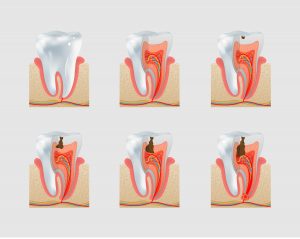“How do you REALLY brush your teeth?” That seems like a silly question. Doesn’t everyone know? You swipe your toothbrush across your teeth a few times twice a day and BAM – you’re covered. Right? Not exactly. There are a few things you need to know before you can master the art of brushing your teeth for maximum effectiveness.
Master the Technique
The American Dental Association recommends brushing your teeth for at least 2 minutes, twice per day, in order to keep your teeth, gums and mouth healthy. Easy to remember: 2 minutes, 2 times per day. So, we know how often to brush, but how do we do it properly? Follow these easy steps:
1. Place the toothbrush at a 45-degree angle against your gums. Move the toothbrush back and forth with gentle short strokes. Repeat this again with circling motions.


- Brush the outer and inner surfaces of your teeth along with the tops, or chewing surfaces, with the same back and forth, then circling strokes.

- Make sure to clean in the inside surfaces of the front teeth by tilting the toothbrush vertically and use up-and-down strokes to clean the teeth. Also, brush your tongue to remove bacteria that can cause bad breath.

These steps apply to children as well as adults. Parents, help your children with this task until they are old enough to properly brush themselves. There are plenty of ways to encourage good dental hygiene habits.
Proper Tools
Tools are equally as important as the technique. Make sure you are using a soft-medium bristled toothbrush, or what your dentist recommends for your particular teeth needs. The size and shape of your toothbrush is determined by the size of your mouth. For example, a child’s size toothbrush wouldn’t be as effective on an adult. A hand-held toothbrush or an electric toothbrush is equally as efficient if you brush properly. Another important factor is keeping your toothbrush clean – yes, after you have brushed the gunk off of your teeth you need to clean your toothbrush. Rinse it with cool water to make sure all toothpaste residues are gone. Also, replace your toothbrush every 3-4 months, or when you see signs of fraying on the bristles. When the bristles point outward, that’s when you know it’s time for a new one.
Don’t Forget
We’ve talked about this before, but it’s always good to be reminded: Don’t forget to floss after you brush! Brushing and flossing are like peanut butter and jelly: the perfect complement. Your toothbrush can’t reach all the crevices of your teeth, so flossing ensures that your pearly whites are as clean as can be. Don’t fret about twice-daily flossing; you only need to floss once per day.
While it is a daily task that we often perform unconsciously, brushing our teeth is the foundation for good oral hygiene. Something that will only take you 4 minutes total per day can help prevent cavities, decay, gum disease and more.
Do you need suggestions on what type of toothbrush to get or help with proper brushing techniques? Call our office or schedule an appointment on our website. We are here for you, our family treating yours.

Recent Comments